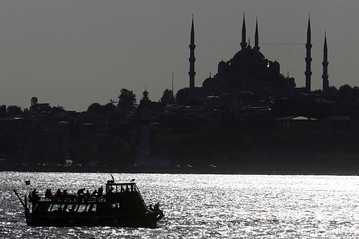By JOE PARKINSON
Reuters
Turkey’s economy has been going great guns this year–but things are starting to get a bit bumpy.
 And policymakers here are gambling that counter-cyclical, pointy-headed policy is the way to ride the waves.
And policymakers here are gambling that counter-cyclical, pointy-headed policy is the way to ride the waves.
The bank’s monetary policy committee on Friday completed the second act of a hocus-pocus plan to simultaneously slow booming credit growth and curb the inflows of hot money that’s threatened to destabilize Turkey’s rapid recovery.
Step one: Late Thursday, the bank cut benchmark interest rates by 50 basis points to 6.5%–a fresh record low. That move was intended to dissuade speculative investments seeking higher yields pouring into Turkey and magnifying the economy’s key weakness: a mushrooming current-account deficit that depends on external finance.
Fine, but a rate cut also threatens to stoke an expanding consumer lending boom, that many economists warn is overheating the economy.
So, on to step two: On Friday morning, policymakers announced that bank reserve ratios would be hiked to 8%, draining 7.6 billion Turkish lira ($4.9 billion) from the market and reducing the amount Turkish banks could lend.
That move mirrors monetary policy measures recently undertaken by China, where the central bank last week lifted banks’ reserve requirement for the third time in a month, in an effort to cool lending.
In Turkey, a rapid recovery underpinned by comfortably capitalized banks has propelled a lending surge.
The economy expanded 8.9% in the nine months to October, posting one of the fastest growth rates of any G20 economy. Expansion has been underpinned by record low interest rates, as the central bank slashed its key rate 13 times from an October 2008 high of 16.75%.
But Turkey’s reliance on imports also saw the country’s trade deficit widen more than 130% on the year in October, spotlighting an imbalance that analysts fear leaves it exposed to external shocks.
Partly because of that model, the quicker Turkey expands, the quicker the deficit widens, leaving the economy vulnerable to shocks if investor sentiment turns negative.
That vulnerability is magnified by the fact that a rapidly rising proportion of that deficit is financed by speculative investments, or hot money. This is the speculative demand that sweeps into rapidly growing economies as investors flee low interest rates in the U.S., the U.K. and the euro zone, to seek higher yields.
So far this year, some 70% of Turkey’s current-account deficit has been financed by speculative portfolio investments, compared to just 14% of longer-term FDI, according to the “Emerging Markets Quarterly Report” published by Barclays Capital, early December.
So policymakers in Ankara have gambled that cutting rates to dissuade speculative investors is less risky than firing a domestic consumer boom that some fear could see the economy overheat.
It’s too early to judge whether the complicated policy shift will have the desired effect: reducing hot money flows and cooling runaway lending rates.
But the policy push has split the market.
Some have praised the CBRT’s boldness, acknowledging that rate-setters are in a tough spot trying to square competing objectives.
“Turkey is having to find policy measures to guide itself through this stage of outperformance versus the rest of the world, which comes as a result of solid policy action of the past,” said Simon Quijano-Evans, an economist at CA Chevreaux in Vienna. “This is not an easy time for the central bank.”
Others are less sanguine, warning that the abrupt shift in policy calls the bank’s credibility into question.
Brown Brothers Harriman said in a research note that the rate cut was “as we feared”, adding that “the attempt to fine tune policy with a combination of policy rate cuts and reserve requirement hikes is a clumsy one.”
via Turkey’s Financial Conundrum – The Source – WSJ.